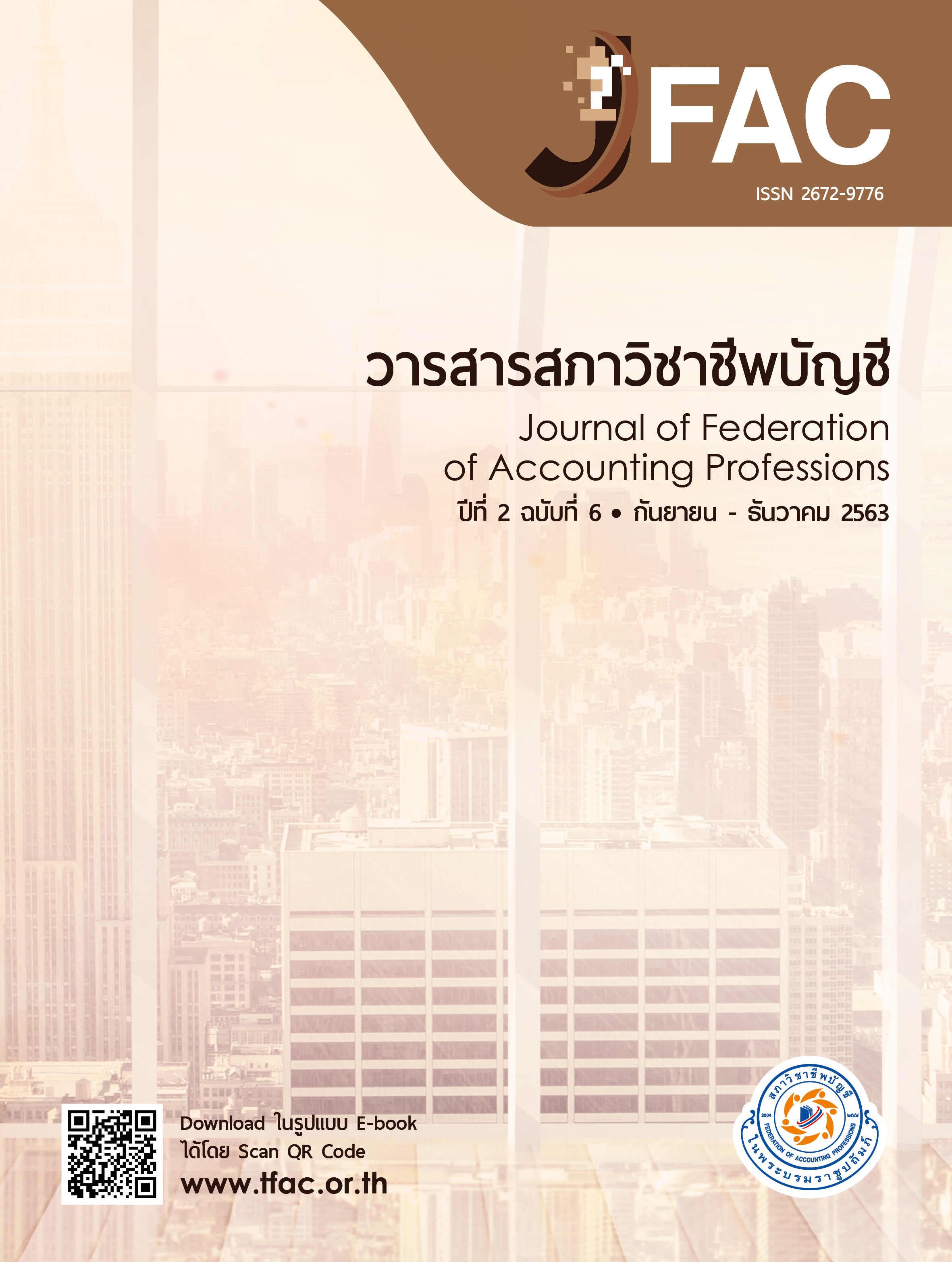หลักการสำคัญของกรอบแนวคิดสำหรับการรายงานทางการเงิน ค.ศ. 2018
Main Article Content
บทคัดย่อ
บทความนี้มีวัตถุประสงค์เพื่ออธิบายหลักการสำคัญที่ระบุไว้ในกรอบแนวคิด (2018) ซึ่งคาดว่าจะใช้ในประเทศไทยในปี พ.ศ. 2564 เนื้อหาของกรอบแนวคิด (2018) ครอบคลุม 8 บท ได้แก่ (1) วัตถุประสงค์ของการรายงานทางการเงินเพื่อวัตถุประสงค์ทั่วไป (2) ลักษณะเชิงคุณภาพของข้อมูลทางการเงินที่มีประโยชน์ (3) งบการเงินและกิจการที่เสนอรายงาน (4) องค์ประกอบของงบการเงิน (5) การรับรู้รายการและการตัดรายการบัญชี (6) การวัดมูลค่า (7) การแสดงรายการและการเปิดเผยข้อมูล และ (8) แนวคิดเรื่องทุนและ การรักษาระดับทุน
Article Details
เนื้อหาและข้อมูลในบทความที่ลงตีพิมพ์ในวารสารสภาวิชาชีพบัญชี ถือเป็นข้อคิดเห็นและความรับผิดชอบของผู้เขียนบทความโดยตรงซึ่งกองบรรณาธิการวารสารไม่จำเป็นต้องเห็นด้วยหรือร่วมรับผิดชอบใด ๆ
บทความ ข้อมูล เนื้อหา รูปภาพ ฯลฯ ที่ได้รับการตีพิมพ์ในวารสารสภาวิชาชีพบัญชี ถือเป็นลิขสิทธิ์ของวารสารสภาวิชาชีพบัญชี หากบุคคลหรือหน่วยงานใดต้องการนำข้อมูลทั้งหมดหรือบางส่วนไปเผยแพร่ต่อหรือเพื่อกระทำการใดๆ จะต้องได้รับอนุญาตเป็นลายลักษณ์อักษรจากวารสารสภาวิชาชีพบัญชี ก่อนเท่านั้น
เอกสารอ้างอิง
ภาษาไทย
กอบแก้ว รัตนอุบล. (2562). การเปลี่ยนแปลงที่สำคัญของกรอบแนวคิดสำหรับการรายงานทางการเงิน ฉบับปรับปรุงปี ค.ศ. 2018: บทที่ 1 – บทที่ 4. วารสารวิชาชีพบัญชี, 15(47), 78-89.
กอบแก้ว รัตนอุบล. (2563). การเปลี่ยนแปลงที่สำคัญของกรอบแนวคิดสำหรับการรายงานทางการเงิน ฉบับปรับปรุงปี ค.ศ. 2018: บทที่ 5 – บทที่ 8. วารสารวิชาชีพบัญชี, 16(51), 70-85.
นิพันธ์ เห็นโชคชัยชนะ. (2558). กรอบแนวคิดสำหรับการรายงานทางการเงิน (ปรับปรุง 2557). วารสารวิชาชีพบัญชี, 11(30), 78-84.
ศิลปพร ศรีจั่นเพชร และอนุวัฒน์ ภักดี. (2563). การบัญชีชั้นกลาง 1. กรุงเทพฯ. ห้างหุ้นส่วนจำกัด ทีพีเอ็น เพลส
สภาวิชาชีพบัญชี ในพระบรมราชูปถัมภ์. (2563). ประกาศสภาวิชาชีพบัญชี ที่ 48/2563 เรื่อง กรอบแนวคิดสำหรับการรายงานทางการเงิน. ออนไลน์ www.tfac.or.th. วันที่ 28 พฤศจิกายน 2563.
ภาษาอังกฤษ
Barth, M. E., Landsman, W. R., and Lang, M. H. (2008). International Accounting Standards and Accounting Quality. Journal of Accounting Research, 46(3), 467-498.
Braam, G. and Beest, F. V. (2013). Conceptually-Based Financial Reporting Quality Assessment. An Empirical Analysis on Quality Differences Between UK Annual Reports and US 10-K Reports. NiCE Working Paper 13-106.
Cuong, N. T. and Ly, D. (2017). Measuring and Assessing the Quality of Information on the Annual Reports: The Case of Seafood’s Companies Listed on the Vietnam Stock Market. International Research Journal of Finance and Economics, 160, 26-40.
Dechow, P., Ge, W. and Schrand, C. (2010). Understanding Earnings Quality: A Review of the Proxies, Their Determinants and Their Consequences. Journal of Accounting and Economics, 50(2), 344-401.
Francis, J., LaFond, R., Olsson, P. M., and Schipper, K. (2004). Costs of Equity and Earnings Attributes. The Accounting Review, 79(4), 967–1010.
IASB. (2018a). Conceptual Framework for Financial Reporting. publications@ifrs.org.
IASB. (2018b). The Conceptual Framework for Financial Reporting: Conceptual Framework Project Summary. Online: https://www.ifrs.org/-/media/project/conceptual-framework/fact-sheet-project-summary-and-feedback-statement/conceptual-framework-project-summary.pdf
Kvatashidze, N. (2019). Impact of Changes of the Conceptual Framework for Financial Reporting on the Indicators of the Financial Statement. World Academy of Science, Engineering and Technology International Journal of Economics and Management Engineering, 13(9), 1177 – 1180.
Okafor, O.N., Anderson, M., and Warsame, H. (2016). IFRS and Value Relevance: Evidence Based on Canadian adoption. International Journal of Managerial Finance, 12(2), 136-160.
Outa, E. R., Ozili, P., and Eisenberg, P. (2017). IFRS Convergence and Revisions: Value Relevance of Accounting Information from East Africa. Journal of Accounting in Emerging Economies, 7(3), 352-368.
Whittington, G. (2008). Harmonisation or Discord? The Critical Role of the IASB Conceptual Framework Review. Journal of Accounting and Public Policy, 27, 495–502.


